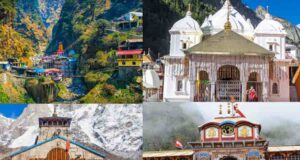Fatehpur Sikri: The Walled Heritage of Agra
Every city has a different story to tell regarding its past. The allegories related to a historical place are narrated by various records and the evidences are found in the form of artifacts and structures of a particular period. Sometimes, the evidence becomes more prominent if it is as vast and as distinctive as Fatehpur Sikri, a town and municipal board in the state of Uttar Pradesh.

Location
Fatehpur Sikri is located in the district of Agra, a major commercial and tourist hub of the state.
History
Fatehpur Sikri was earlier known as the Sikrigarh due to its proximity with the ancient city of Sikri. The credit of constructing this historical place goes to Maharana Sangram Singh, an emperor of the Sikriwal Rajputs.
Akbar, the third Mughal Emperor, repeatedly attacked the town before he finally conquered it on his seventh attack. He renamed the city as Fatehpur, which translated to the victory colony. Akbar used this town as the administrative headquarter from 1571 to 1585.
During his reign, Akbar planned to construct a walled city at Fatehpur, which included the palaces, mosque, private quarters, courts and several other buildings of importance. Akbar supervised the construction of all these buildings, which took fifteen years in planning and execution.
Though the imperial palace complex was one of the most prominent parts of the town, it was abandoned by the royal family due to scarcity of water and closeness with the Rajputana areas, from where the rulers could launch an attack anytime owing to the tumultuous conditions. Akbar decided to move away from Agra to avoid any warlike conditions and shifted his capital to Lahore, from where he ruled for the next thirteen years.
In 1598, he moved back to Agra, only to be distracted by the Deccan area which he found more suitable for establishing his capital. From here on, Akbar never looked back at the city of Agra except for a brief while in 1601.
Fatehpur Sikri remained abandoned for a period of more than a century, before it was occupied by Muhammad Shah, a Mughal emperor, in 1719.
Structure
Fatehpur Sikri is built over a raised platform of a hill. A wall, six kilometres in length, surrounds the city from all sides except one, as there used to be a lake there during the time it was occupied by the royal family.
The construction was executed in accordance with the Indian principles under the leadership of Tuhir Das as the chief architect. Different Indian architectural patterns were used to create designs of various structures which were erected by hardworking and skilled laborers. All the structures were made of red sandstone, quarried in the town itself, also called the Sikri sandstone.
There are nine entrances to the city through gates built in the fort wall.
What to See
Inside the city, there are several monuments of interest for the visitors. These include:
Buland Darwaza
The Buland Darwaza leads to the palace city. This is a 54 feet high door, which gradually decreases as one passes through. It is located at the south of the mosque and was built five years after completion of the mosque, basically to commemorate Akbar’s successful campaigning in Gujarat. There are inscriptions on the archway.
To the outer side of this door is a deep well and inside there are three entrance points.
Jama Masjid
One of the earliest structures built inside the city, this mosque was made for the Friday congregation.
Salim Chisti’s Tomb The Sufi saint was buried here in a marble encasing. The tomb is decorated with intricate patterns on the screens surrounding it. There is a passageway for performing circumambulation.
The tomb is built next to the tomb of Islam Khan I, his grandson, where graves of other male descendants of the Chisti clan are built.
Diwan-E-Khas
The hall for private audience, Diwan-E-Khas, is adorned by an intricately designed pillar in its centre. The top of the pillar served as a platform for Akbar, who used to discuss religiously significant issues with representatives and other private discussions.
Diwan-E-Aam
This hall was built for meetings held with the general public.
Ibadat Khana (House of Worship)
A meeting house where Akbar laid the foundations of a newly formed faith, Din-E-Ilahi.
Hujra-i-Anup Talao
It is said that Akbar’s Muslim wife used to reside in this section though its size raises doubts as to whether a queen would have agreed to live here.
Mariam-uz-Zamani’s Palace
Situated around the courtyard, this palace was influenced from Gujarati architectural patterns.
Anup Talao
This pool is surrounded by Akbar’s residence Khwabgaah, a five-storey palace called Panch Mahal, Astrologer’s Seat and Diwan-E-Khas.
Other important structures in the city include Birbal’s House, Karkhanas, Khazana, Daftar Khana, Naubat Khana etc.
Eat, Drink, Collect
Agra is famous for its Mughlai cuisine, which you can eat in plenty of restaurants scattered across the town. Apart from Mughlai dishes, you can also enjoy Indian, Chinese and Continental cuisines at these restaurants.
Alcoholic beverages are available in the many bars in the city.
Accommodation is available at one of the many hotels and lodges in Agra. The rates might differ depending on the in flow of tourists in the city, and it is advised that you should bargain to find a perfect deal.
Best Time to Visit
Fatehpur Sikri is open to visitors from sunrise to sunset, thus giving everybody a lot of time to explore the various corners of this ancient site.
Indian citizens and tourists arriving from SAARC and BIMSTEC countries are charged Rs. 10/- per head towards admission.
Tourists arriving from other countries are charged US $5 or Rs 250/- per head towards admission. Entry to visitors up to fifteen years of age is non-chargeable.
Entry to all the visitors is free on Friday.
Tourist should plan their visit during the months of October through March, as the weather during this period is favorable to explore the vastness of the walled city.
How to Reach
Fatehpur Sikri is located at a distance of around 39 kilometres from the Agra district, which in turn is well connected with other parts of the state and country through a well-developed road, rail and air network.
Fatehpur Sikri is at a distance of 204 kilometres from Delhi, the national capital. The presence of an international airport allows the international tourists to reach here in a few hours after they land in India. Regular buses and private taxis run from the airport to Agra and Fatehpur Sikri throughout the day.
Passenger trains and local buses along with private taxis are available from Agra in plenty due to the its popularity as a historical tourist place across the world.


